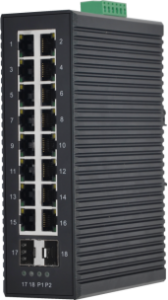Switching is a general term for technologies that send the information to be transmitted to the corresponding routing that meets the requirements by manual or automatic equipment according to the requirements of transmitting information at both ends of the communication. According to different working positions, it can be divided into wide area network switch and local area network switch. The switch of the wide area network is a kind of equipment that completes the information exchange function in the communication system. So, what are the forwarding methods of the switch? Next, let’s follow JHA Technology to learn more about it!
Forwarding method:
1.Cut-through switching
2.Store-and-Forward switching
3.Fragment-free switching
This article only focuses on the first and second methods.
Both cut-through switching and store-and-forward switching are a L2 forwarding method, and their forwarding strategies are based on the destination MAC (DMAC). In this regard, there is no difference between the two forwarding methods.
The biggest difference between them is when they deal with forwarding, that is, how the switch deals with the relationship between the receiving process and forwarding process of the data packet.
Forwarding type:
1. Cut Through
Cut Through’s Ethernet switch can be understood as a line matrix telephone switch that crosses each port. When it detects a data packet at the input port, it checks the packet header, obtains the destination address of the packet, activates the internal dynamic lookup table to convert it into the corresponding output port, connects at the intersection of input and output, and passes the data packet directly to The corresponding port realizes the switching function. Since no storage is required, the delay is very small and the exchange is very fast, which is its advantage.
Its disadvantage is that because the content of the data packet is not saved by the Ethernet switch, it cannot check whether the transmitted data packet is wrong, and it cannot provide error detection capabilities. Because there is no buffer, input/output ports with different speeds cannot be connected directly, and packets are easily lost.
2. Store-and-Forward switching
The store-and-forward method is the most widely used method in the field of computer networks. It checks the data packet of the input port, takes out the destination address of the data packet after processing the error packet, and converts it into the output port to send the packet through the lookup table. Because of this, the store-and-forward method has a large delay in data processing, which is its shortcoming, but it can perform error detection on the data packets entering the switch and effectively improve network performance. It is especially important that it can support the conversion between ports of different speeds and maintain the cooperation between high-speed ports and low-speed ports.
3. Fragment Free
This is a solution between the first two. It checks whether the length of the data packet is enough for 64 bytes, if it is less than 64 bytes, indicating that it is a fake packet, then discard the packet; if it is greater than 64 bytes, then send the packet. This method also does not provide data verification. Its data processing speed is faster than store-and-forward, but slower than straight-through.
Whether it is direct forwarding or store forwarding, it is a two-layer forwarding method, and their forwarding strategy is based on the destination MAC (DMAC). There is no difference between the two forwarding methods in this regard. The biggest difference between them is when they handle forwarding, that is, how the switch handles the relationship between the receiving process and the forwarding process of the data packet.
Post time: Dec-11-2020






